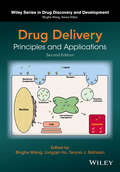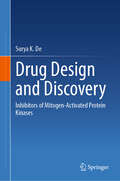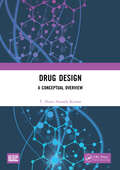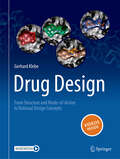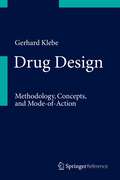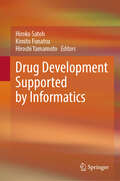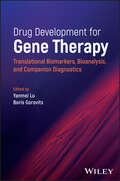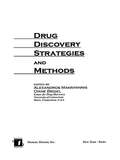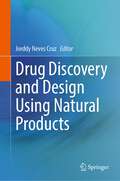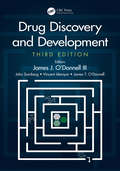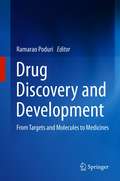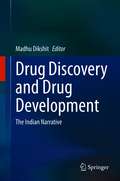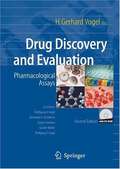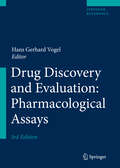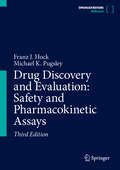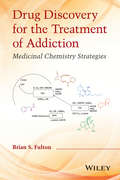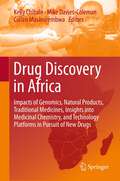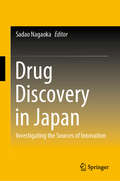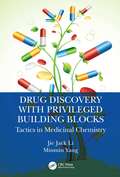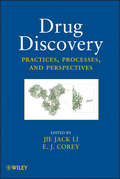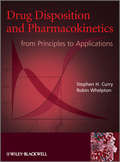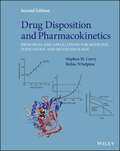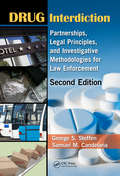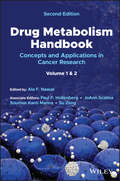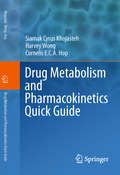- Table View
- List View
Drug Delivery: Principles And Applications
by Binghe Wang Longqin Hu Teruna J. SiahaanFollowing its successful predecessor, this book covers the fundamentals, delivery routes and vehicles, and practical applications of drug delivery. In the 2nd edition, almost all chapters from the previous are retained and updated and several new chapters added to make a more complete resource and reference. * Helps readers understand progress in drug delivery research and applications * Updates and expands coverage to reflect advances in materials for delivery vehicles, drug delivery approaches, and therapeutics * Covers recent developments including transdermal and mucosal delivery, lymphatic system delivery, theranostics * Adds new chapters on nanoparticles, controlled drug release systems, theranostics, protein and peptide drugs, and biologics delivery
Drug Design and Discovery: Inhibitors of Mitogen-Activated Protein Kinases
by Surya K. DeThis book covers the important role small molecules can play in the modulation of stress-activated protein kinase (SAPK), also called the mitogen-activated protein kinase (MAPK) pathway, and the potential this may offer in enabling the development of future medicine therapies. It is clear that MAP kinase pathway therapies could continue to drive increasing interest in the field, both within academic laboratories and also in the biotechnology and pharmaceutical sectors. This book provides an overview of protein kinase inhibitors, the biological roles of MAP kinases, ATP-competitive and non-competitive inhibitors, covalent inhibitors, and more. This book is intended for professors in academia, researchers in pharmaceutical and biotechnology sectors working on protein kinases, and graduate students in pharmacy/chemistry.
Drug Design: A Conceptual Overview
by T. Durai KumarThe newer research areas in pharmaceutical sciences, particularly molecular modeling and simulations, prompted a more efficient drug discovery process. Informatics integrated with pharmaceutical sciences (cheminformatics and bioinformatics) became an essential component of drug research. Drug informatics such as genomics and proteomics assists in the Rational Drug Design (RDD). This emerging discipline is known as “Computer-Aided Drug Design" (CADD), which has profound application in RDD. The advanced and adequate practice in drug design informatics is essential for pharmacy graduates. Hence, a companion for acquiring knowledge on these concepts is vital. The students of B. Pharmacy, M. Pharmacy (Pharmaceutical Chemistry, Pharmacology, and Pharmaceutics), biotechnology, biomedical engineering and other interdisciplinary fields may find this book as a reference guide. The salient features of this book are: • Systematic and simple approach • Emphasis on traditional and modern drug design strategies • Comprehensive coverage for the current advances in the drug design • Experimental section to ensure hands-on-experience Note: T& F does not sell or distribute the Hardback in India, Pakistan, Nepal, Bhutan, Bangladesh and Sri Lanka.
Drug Design: From Structure and Mode-of-Action to Rational Design Concepts
by Gerhard KlebeThis English-language textbook, based on the successful German edition 'Wirkstoffdesign', brings the subject of drug design back to the cutting edge of research. The reader learns about new methods in genetic engineering and the expanded range of structural biological methods. Especially in the last 10 years, many complex target structures such as G-protein coupled receptors or ion channels have been elucidated by using these methods. The reader learns how these long-sought complex structures with classical drugs look like and how the therapeutic effect is achieved.This textbook is aimed at students of pharmacy, chemistry and the life sciences, but also at career changers and medicinal chemists in research and development departments of the pharmaceutical industry. Conceptually, it is very different from classical textbooks on pharmaceutical chemistry. It focuses on the path to a new drug substance. The selection of case studies is based on didactic aspects and attempts to give a broad overview of methods and strategies without forgetting to look back at the beginnings of this field of work. Thus, the arc spans from the history of drug research, the mechanisms of action of drugs and the methods for lead structure search and optimisation to structure determination methods, modelling, molecular dynamics and QSAR methods to structure- and computer-aided design.This textbook also discusses new methods and concepts such as epigenetics, the PROTAC approach, CRISPR-Cas9 gene scissors, structural predictions from sequence, the use of artificial intelligence and new screening technologies from biophysics. It presents successes in disrupting or enhancing protein-protein interactions as a concept for drug therapy and discusses optimising drugs considering their thermodynamic as well as kinetic binding profiles .Videos via app: simply download the SN More Media app free of charge, scan a link with the play button and immediately play the video on your smartphone or tablet.
Drug Design: Methodology, Concepts, and Mode-of-Action
by Gerhard KlebeUnique work on structure-based drug design, covering multiple aspects of drug discovery and development. Fully colored, many images, computer animations of 3D structures (these only in electronic form). Makes the spatial aspects of interacting molecules clear to the reader, covers multiple applications and methods in drug design. Structures by mode of action, no therapeutic areas. Of high relevance for academia and industrial research. Focus on gene technology in drug design, omics-technologies computational methods experimental techniques of structure determination multiple examples on mode of action of current drugs, ADME-tox properties in drug development, QSAR methods, combinatorial chemistry, biologicals, ribosome, targeting protein-protein interfaces.
Drug Development Supported by Informatics
by Hiroko SatohThis book describes the state-of-the-art of chemoinformatics, bioinformatics, materials informatics and measurement/metrology informatics to develop drugs with desired activity or physicochemical properties and to optimize the functionality, efficacy, safety and quality of the compounds for drugs. Recently, "AI drug discovery", drug discovery research utilizing artificial intelligence technology such as machine learning, has attracted much attention. This book provides an overview of the four applied informatics fields and their applications in drug development for a wide spectrum of readers from learners to professional scientists in academia and industry. It focuses on the basic research stage of drug development with contributions from experts at the forefront of these fields. The authors hope that this book will be of assistance to explore new opportunities for collaboration between pharmaceutical science and informatics.
Drug Development for Gene Therapy: Translational Biomarkers, Bioanalysis, and Companion Diagnostics
by Yanmei Lu Boris GorovitsDrug Development for Gene Therapy Industry-centric perspective on translational and bioanalytical challenges and best practices for gene therapies Drug Development for Gene Therapy focuses on the translational and bioanalytical challenges and best practices for gene therapy modalities, presenting a significant body of data, including information related to safety and efficacy, necessary to advance through the development pipeline into clinical use. The text covers bioanalytical methods and platforms including patient screening assays, different PCR tests, enzyme activity assays, ELISpot, NGS, LC/MS, and immunoassays, with FDA and EMA guidelines on gene therapy safety and efficacy, along with companion diagnostics regulations from US and EU perspectives. The chapters offer an in-depth discussion of the basics and best practices for translational biomarkers, bioanalysis, and developing companion diagnostics / lab tests for gene therapies in the pharma and biopharma industries. To aid in reader comprehension, the text includes clinical examples of relevant therapies in related chapters. Some of the core topics covered include study design, immunogenicity, various bioanalytical methods and their applications, and global regulatory issues. Written by two highly qualified authors with significant experience in the field, Drug Development for Gene Therapy includes information on: Bioanalytical methods to detect pre-existing antibodies against adeno-associated viruses (AAV) capsids Detection of cellular immunity and humoral response to viral capsids and transgene proteins, and immunogenicity of gene therapy products Nonclinical and clinical study considerations and methods for biodistribution and shedding Quantification of transgene protein expression and biochemical function, and substrate and distal pharmacodynamic biomarker measurements for gene therapy Detection and quantification of rAAV integration and off-target editing Current regulatory landscape for gene therapy product development and the role of biomarkers and general regulatory considerations for gene therapy companion diagnostics With comprehensive coverage of the subject, Drug Development for Gene Therapy is a must-have resource for researchers and developers in the areas of pharmaceuticals, biopharmaceuticals, and contract research organizations (CROs), along with professors, researchers, and advanced students in chemistry, biological, biomedical engineering, pharmaceuticals, and medical sciences.
Drug Discovery Strategies and Methods
by Alexandros Makriyannis Diane BiegelNavigate the complex and multidisciplinary path of drug discovery procedures with Drug Discovery Strategies and Methods-a well-organized and timely reference that analyzes methods in target identification and validation, lead detection, compound optimization, and biological testing. This volume addresses challenges encountered during the discovery
Drug Discovery and Design Using Natural Products
by Jorddy Neves CruzHistorically, natural products have great relevance for the development of new drugs. Natural molecules, in addition to directly providing new compounds with different therapeutic functions have provided scaffolds and a great diversity of structures that serve as inspiration for the design and discovery of new drugs. The great structural complexity and the significant number of natural compounds that can be obtained and their advantages also present some historical problems that need to be overcome. Issues such as difficulty in isolation, difficulty in synthesizing compounds found in nature in the laboratory, screening to evaluate the biological properties of these compounds, and structural optimization to enhance the pharmacological properties of biomolecules; are some of the main difficulties encountered in research with natural products and in the design/discovery of new medicines. Therefore, this book addresses the great scientific advances that provide practical solutions to using natural products to develop new drugs. We address topics related to the genesis of research projects that use natural products to design new drugs. We address the discovery of new species, initial processes for identification and extraction of compounds, isolation and identification of these structures, techniques, and advances in vitro and in vivo methods that support the discovery of new natural drugs, synthesis of new compounds from natural molecules, in silico optimization processes of potentially promising compounds.
Drug Discovery and Development, Third Edition
by James J. O'Donnell John Somberg Vincent Idemyor James T. O'DonnellDrug Discovery and Development, Third Edition presents up-to-date scientific information for maximizing the ability of a multidisciplinary research team to discover and bring new drugs to the marketplace. It explores many scientific advances in new drug discovery and development for areas such as screening technologies, biotechnology approaches, and evaluation of efficacy and safety of drug candidates through preclinical testing. This book also greatly expands the focus on the clinical pharmacology, regulatory, and business aspects of bringing new drugs to the market and offers coverage of essential topics for companies involved in drug development. Historical perspectives and predicted trends are also provided. Features: Highlights emerging scientific fields relevant to drug discovery such as the microbiome, nanotechnology, and cancer immunotherapy; and novel research tools such as CRISPR and DNA-encoded libraries Case study detailing the discovery of the anti-cancer drug, lorlatinib Venture capitalist commentary on trends and best practices in drug discovery and development Comprehensive review of regulations and their impact on drug development, highlighting special populations, orphan drugs, and pharmaceutical compounding Multidiscipline functioning of an Academic Research Enterprise, plus a chapter on Ethical Concerns in Research Contributions by 70+ experts from industry and academia specialists who developed and are practitioners of the science and business
Drug Discovery and Development: From Targets and Molecules to Medicines
by Ramarao PoduriThis book describes the processes that are involved in the development of new drugs. The authors discuss the history, role of natural products and concept of receptor interactions with regard to the initial stages of drug discovery. In a single, highly readable volume, it outlines the basics of pharmacological screening, drug target identification, and genetics involved in early drug discovery. The final chapters introduce readers to stem therapeutics, pharmacokinetics, pharmacovigilance, and toxicological testing. Given its scope, the book will enable research scholars, professionals and young scientists to understand the key fundamentals of drug discovery, including stereochemistry, pharmacokinetics, clinical trials, statistics and toxicology.
Drug Discovery and Drug Development: The Indian Narrative
by Madhu DikshitOver the years, India has attained a prominent global position in the manufacture of Generic Drugs. This success can be attributed to its synthetic organic chemistry and chemical engineering strengths, nurtured by the timely policies of the Government of India. However, breakthrough successes in New Drug Discovery have remained elusive, despite the brilliant and sustained efforts of many Indian researchers and Pharma establishments. The Indian National Science Academy thought it appropriate to document India’s New Drug Discovery Research (NDDR) journey to date. Gathering contributions from prominent researchers in the Indian Pharma Industry and Academia, this book highlights their efforts, achievements, and the status quo of Indian NDDR.
Drug Discovery and Evaluation: Pharmacological Assays
by Hans G. VogelNow expanded and updated to include molecular biology and genetic engineering techniques. The second edition of this successful reference book contains a comprehensive selection of the most frequently used assays for reliably detecting the pharmacological effects of potential drugs. Each of the more than 1000 assays comprises a detailed protocol outlining the purpose and rationale of the method, a critical assessment of the results and their pharmacological and clinical relevance. The enclosed and fully searchable CD ROM allows easy identification of specific tests. An appendix with up-to-date guidelines and legal regulations for animal experiments in various countries will help the reader to plan experiments more effectively.
Drug Discovery and Evaluation: Pharmacological Assays
by Hans VogelThe new edition of this successful reference offers both cutting-edge and classic pharmacological methods. Thoroughly revised and expanded to two volumes, it offers an updated selection of the most frequently used assays for reliably detecting the pharmacological effects of potential drugs. Every chapter has been updated, and numerous assays have been added. Each of the more than 1,000 assays comprises a detailed protocol outlining purpose and rationale, and a critical assessment of the results and their pharmacological and clinical relevance.
Drug Discovery and Evaluation: Safety and Pharmacokinetic Assays
by Michael K. Pugsley Franz J. HockMany aspects of drug safety have become an outstanding and even persistent issue and may occur during the process of both drug discovery and development. Until 15 years ago, drug discovery and evaluation was primarily a sequential process starting with the selection of the most pharmacologically active compound from a series of newly synthesized small molecule chemical series by means of distinctive pharmacological assays. Safety aspects were addressed by evaluation of the selected compound at high doses in a series of specific studies directed at indications other than the intended indication of the new compound. These tests are then followed by pharmacokinetic studies, which are primarily conducted to confirm whether the selected compound possesses a suitable half-life for sufficient exposure and efficacy and, whether it has the desired properties specificity to the intended route of administration. Safety aspects relied predominantly on the conduct of single and repeat toxicologydose studies, which inform changes in organ structure rather than organ function. Both toxicological and pharmacokinetic studies are adapted to the progress of studies in clinical pharmacology and clinical trials. The new edition of this well and broadly accepted reference work contains several innovative and distinguished chapters. This "sequential" strategy has been abandoned with this new version of the book for several reasons: - Of the possible multitude of negative effects that novel drugs may impart on organ function, e.g. ventricular tachy-arrhythmia, many are detected too late in non-clinical studies to inform clinicians. On the other hand, negative findings in chronic toxicity studies in animals may turn out to be irrelevant for human beings. - New scientific approaches, e.g. high-throughput screening, human pluripotent stem cells, transgenic animals, knock-out animals, in silico models, pharmaco-genomics and pharmaco-proteomics, as well as Artificial Intelligence (AI) methods offered new possibilities. - There are several examples, that show that the "druggability" of compounds was considerably underestimated when the probability of success of a new project was assessed. The success rate in the pharmaceutical industry and the introduction of new chemical entities to the market per year dropped dramatically, whereas the development time for a new compound increased, sometimes exceeding the patent protection. Research and development scientists, involving the following changes, therefore adopted a change of strategy: - Parallel instead of sequential involvement of the various disciplines (multidimensional compound optimization). - The term "Safety Pharmacology" was coined. The International Conference on Harmonization (ICH) founded a Safety Pharmacology Working Group and the Safety Pharmacology Society (SPS) was launched. The discipline provided for evaluation, development and validation of a multitude of safety tests outlined in the 'Core Battery of Studies'. - Characterizing the exposure profile of a drug by conducting pharmacokinetic studies that evaluates the absorption, distribution, metabolism and excretion should to be investigated at an early stage of development as results contribute to the selection of a compound for further development. Advancements in Toxicology were achieved by the introduction of new methods, e.g., in silico methods, genetic toxicology, computational toxicology and AI. The book is a landmark in the continuously changing world of drug research and developments. As such, it is essential reading for many groups: not only for all students of pharmacology and toxicology but also for industry scientists and physicians, especially those involved in clinical trials of drugs, and for pharmacists who must know the safety requirements of drugs. The book is essential for scientists and managers in the pharmaceutical
Drug Discovery for the Treatment of Addiction
by Brian S. FultonWith addiction a key target for drug discovery efforts, this book fills an important and timely need for medicinal chemists who need to understand complex neuroscience issues. The author illustrates medicinal chemistry's prominent role in treating addiction and covers specific drugs of abuse including narcotics, stimulants, depressants, nicotine, and marijuana. * Interprets complex neuro- biological and pharmacological information, like the drug-reward system, for medicinal chemists * Emphasizes neurotransmitters and neurochemical mechanisms of addictive drugs * Pulls together information on the many potential drug targets for treating addiction * Stresses unique medicinal chemistry problems when describing pharmacology testing methods and drug development
Drug Discovery in Africa
by Kelly Chibale Mike Davies-Coleman Collen MasimirembwaDrug discovery originating in Africa has the potential to provide significantly improved treatment of endemic diseases such as malaria, tuberculosis and HIV/AIDS. This book critically reviews the current status of drug discovery research and development in Africa, for diseases that are a major threat to the health of people living in Africa. Compiled by leading African and international experts, this book presents the science and strategies of modern drug discovery. It explores how the use of natural products and traditional medicines can benefit from conventional drug discovery approaches, and proposes solutions to current technological, infrastructural, human resources, and economic challenges, which are presented when attempting to engage in full-scale drug discovery. Topics addressed are varied; from African medicinal plants to marine bioprospecting, pharmacogenetics and the use of nanotechnology. This book brings together for the first time a collection of strategies and techniques that need to be considered when developing drugs in an African setting. It is an unprecedented and truly international effort, highlighting the remarkable effort made so far in the area of drug discovery research by African scientists, and scientists from other parts of the world working on African health problems.
Drug Discovery in Japan: Investigating the Sources of Innovation
by Sadao NagaokaThis book analyzes the drug-discovery process in Japan, based on detailed case studies of 12 groups of 15 innovative drugs. It covers the first statin in the world up to the recent major breakthrough in cancer therapy, the recent immune checkpoint inhibitor, the scientific discovery for which a 2018 Nobel Prize in Physiology or Medicine was awarded to Prof. Tasuku Honjo, Kyoto University. The book shows the pervasive high uncertainty in drug discovery: frequent occurrences of unexpected difficulties, discontinuations, serendipities, and good luck, significantly because drug discovery starts when the underlying science is incomplete. Thus, there exist dynamic interactions between scientific progress and drug discovery. High uncertainty also makes the value of an entrepreneurial scientist high. Such scientists fill the knowledge gaps by absorbing external scientific progress and by relentless pursuit of possibilities through their own research, often including unauthorized research, to overcome crises. Further, high uncertainty and its resolution significantly characterize the evolution of competition in the drug industry. The patent system promotes innovation under high uncertainty not only by enhancing appropriability of R&D investment but also by facilitating the combination of knowledge and capabilities among different firms through disclosure. Understanding such a process significantly benefits the creation of innovation management and policy practices.
Drug Discovery with Privileged Building Blocks: Tactics in Medicinal Chemistry
by Jie Jack Li Minmin YangDrug Discovery with Privileged Building Blocks traces back PharmaBlock’s founding philosophy of designing privileged building blocks. High-quality building blocks are crucial not only to biological activities of different molecules but also to ADMET properties, which eventually will impact the success rate of drug discovery projects. A thorough study of how building blocks perform in drug molecules and a regular analysis of new building block structures in the latest researches have proven to be a fruitful strategy to generate novel building blocks. Using this strategy, PharmaBlock has supplied the drug industry with a great number of building blocks, which are increasingly being adopted by drug hunters, and these are identified in this book. Each chapter may be read and studied without learning the previous chapters. This book will be a good starting point for novice medicinal chemists, and veteran medicinal chemists will find it useful as well. Key Feature The book covers privileged building blocks appearing most frequently on patents for novel drugs. The latest relevant tactics are explained in the context of drug design and medicinal chemistry. Key synthesis, especially large-scale synthesis, is described. The most recent literature references are cited.
Drug Discovery: Practices, Processes, and Perspectives
by Jie Jack Li E. J. CoreySets forth the history, state of the science, and future directions of drug discovery Edited by Jie Jack Li and Nobel laureate E. J. Corey, two leading pioneers in drug discovery and medicinal chemistry, this book synthesizes great moments in history, the current state of the science, and future directions of drug discovery into one expertly written and organized work. Exploring all major therapeutic areas, the book introduces readers to all facets and phases of drug discovery, including target selection, biological testing, drug metabolism, and computer-assisted drug design. Drug Discovery features chapters written by an international team of pharmaceutical and medicinal chemists. Contributions are based on a thorough review of the current literature as well as the authors' firsthand laboratory experience in drug discovery. The book begins with the history of drug discovery, describing groundbreaking moments in the field. Next, it covers such topics as: Target identification and validation Drug metabolism and pharmacokinetics Central nervous system drugs In vitro and in vivo assays Cardiovascular drugs Cancer drugs Each chapter features a case study, helping readers understand how science is put into practice throughout all phases of drug discovery. References at the end of each chapter serve as a gateway to groundbreaking original research studies and reviews in the field. Drug Discovery is ideal for newcomers to medicinal chemistry and drug discovery, providing a comprehensive overview of the field. Veterans in the field will also benefit from the perspectives of leading international experts in all aspects of drug discovery.
Drug Disposition and Pharmacokinetics
by Robin Whelpton Stephen H. CurryThis is an authoritative, comprehensive book on the fate of drug molecules in the body, including implications for pharmacological and clinical effects. The text provides a unique, balanced approach, examining the specific physical and biological factors affecting the absorption, distribution, metabolism and excretion of drugs, together with mathematical assessment of the concentrations in plasma and body fluids. Understanding the equations requires little more than a basic knowledge of algebra, laws of indices and logarithms, and very simple calculus. A companion web site contains additional illustrations, further equations and numerous worked examples.Whilst this book has its roots in the highly acclaimed book of the same name, written by Stephen Curry nearly thirty years ago, it is essentially a new book having been restructured and largely rewritten. This readable and informative book is an invaluable resource for professionals and students needing to develop a rational approach to the investigation and application of drugs.
Drug Disposition and Pharmacokinetics: Principles and Applications for Medicine, Toxicology and Biotechnology
by Robin Whelpton Stephen H. CurryDrug Disposition and Pharmacokinetics The most up-to-date edition of a leading reference in drug disposition and pharmacokinetics In this new, fully-revised edition of Drug Disposition and Pharmacokinetics: Principles and Applications for Medicine, Toxicology and Biotechnology the authors deliver an authoritative and comprehensive discussion of the fate of drug molecules in the body, as well as its implications for pharmacological and clinical effects. The text offers a unique and balanced approach that combines discussion of the specific physical and biological factors affecting the absorption, distribution, metabolism, and excretion of drugs, with mathematical assessments of plasma and body fluid concentrations. The book assumes little prior knowledge and is an ideal reference for practicing professionals in industry as well as researchers and academics. This latest edition provides readers with a new introductory chapter, as well as new chapters covering monoclonal antibodies, the role of stereochemistry in drug disposition and pharmacokinetics, DMPK in non-human species, and the recent use of AI in drug development. Readers will also find: Thorough introductions to drug disposition, pharmacokinetics, and pharmacokinetic modeling In-depth treatments of the kinetics of drug elimination and the relationship between concentration and effect, including PK–PD modeling Comprehensive discussions of predictive pharmacokinetics and the disposition of biological molecules, including peptides and monoclonal antibodies Detailed examinations of the effects of sex, pregnancy, age, and disease, as well as drug monitoring in therapeutics and the use of AI in drug development and treatment Perfect for professionals and researchers working with the scientific aspects of drug disposition in human and veterinary medicine, toxicology, and pharmacology. Drug Disposition and Pharmacokinetics will earn a place in the libraries of students of senior-level courses in pharmacy.
Drug Interdiction: Partnerships, Legal Principles, and Investigative Methodologies for Law Enforcement, Second Edition
by George S. Steffen Samuel M. CandelariaAs drug trafficking and the abuse of illicit drugs continue to inflict untold harm upon our society, it is clear that a global initiative and an intense domestic strategy are vital to address the sophisticated drug trafficking organizations (DTOs) that are prevalent in many regions. Covering a wide array of domestic interdiction topics, Drug Interd
Drug Metabolism Handbook: Concepts and Applications in Cancer Research
by Paul F. Hollenberg JoAnn Scatina Soumen Kanti Manna Su ZengA comprehensive explanation of drug metabolism concepts and applications in drug development and cancer treatment In the newly revised second edition of Drug Metabolism Handbook: Concepts and Applications in Cancer Research, a distinguished team of researchers delivers an incisive and robust exploration of the drug metabolism system and a well-illustrated and detailed explanation of the latest tools and techniques used in the research, pharmacology, and medicine. The book discusses the creation of new molecular entities, drug development, troubleshooting, and other highly relevant concepts, guiding readers through new applications in pharmaceutical research, development, and assessment. The latest edition offers updated content on metabolism basics and the application of a variety of new techniques to cancer treatment, including mass spectrometry, imaging, metabolomics, and immunotherapy. It also offers in-depth case studies highlighting the role of metabolism in drug development. Readers will also benefit from: A thorough introduction to drug metabolism, including a historical perspective, factors affecting metabolism, and biotransformations in drug metabolism Comprehensive discussions of technologies for in vitro and in vivo studies, including mass spectrometry and accelerating metabolite identification with mass spectrometry In-depth explorations of drug interactions, including discussions of enzyme inhibition and the characterization of cytochrome P450 mechanism-based inhibition Fulsome treatments of drug toxicity, including the role of drug metabolism in toxicity, and allergic reactions to drugsPerfect for medicinal chemists, pharmaceutical scientists, and toxicologists, Drug Metabolism Handbook: Concepts and Applications in Cancer Research, Second Edition will also earn a place in the libraries of analytical chemists and drug discovery professionals.
Drug Metabolism and Pharmacokinetics Quick Guide
by Cornelis E.C.A. Hop Harvey Wong Siamak Cyrus KhojastehDrug Metabolism and Pharmacokinetics Quick Guide covers a number of aspects of drug assessment at drug discovery and development stages, topics such as pharmacokinetics, absorption, metabolism, enzyme kinetics, drug transporters, drug interactions, drug-like properties, assays and in silico calculations. It covers key concepts, with useful tables on physiological parameters (eg. blood flow to organs in x-species, expression and localization of enzymes and transporters), chemical structure, nomenclature, and moieties leading to bioactivation (with examples). Overall it includes a number of key topics useful at the drug discovery stage, which would serve as a quick reference with several examples from the literature to illustrate the concept.
